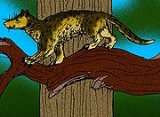
Miacis
Encyclopedia
The 'genus' Miacis contains extinct species of carnivorous mammals that appeared in the late Paleocene
and continued through the Eocene
. The genus Miacis is not monophyletic but a diverse collection of species that belong to the stemgroup within the Carnivoramorpha
. As such, most Miacis species belong to the group of early carnivores that represent the ancestors of the modern order, the crown-group Carnivora
. However, the species Miacis cognitus
is placed not in the stem-group but among the Caniformia
, one of the two suborders of the crown-group Carnivora
.
Miacis species were five-clawed, about the size of a weasel (~30 cm), and lived on the North American and European continents. They retained some primitive characteristics such as low skulls, long slender bodies, long tails, and short legs. Miacis retained 44 teeth, although some reductions in this number were apparently in progress and some of the teeth were reduced in size.
The hind limbs were longer than the forelimbs, the pelvis was doglike in form and structure, and some specialized traits were present in the vertebrae. It had retractable claws, agile joints for climbing, and binocular vision. Miacis and related forms had brains that were relatively larger than those of the creodonts, and the larger brain size as compared with body size probably reflects an increase in intelligence.
Like many other early carnivoramorphans, it was well suited for an arboreal climbing lifestyle with needle sharp claws, and had limbs and joints that resemble those of modern carnivorans. Miacis was probably a very agile forest dweller that preyed upon smaller animals, such as small mammal
s, reptile
s, and bird
s, and might have also have eaten eggs and fruits.
Paleocene
The Paleocene or Palaeocene, the "early recent", is a geologic epoch that lasted from about . It is the first epoch of the Palaeogene Period in the modern Cenozoic Era...
and continued through the Eocene
Eocene
The Eocene Epoch, lasting from about 56 to 34 million years ago , is a major division of the geologic timescale and the second epoch of the Paleogene Period in the Cenozoic Era. The Eocene spans the time from the end of the Palaeocene Epoch to the beginning of the Oligocene Epoch. The start of the...
. The genus Miacis is not monophyletic but a diverse collection of species that belong to the stemgroup within the Carnivoramorpha
Carnivoramorpha
Carnivoramorpha are a clade of mammals that includes the modern order Carnivora and its closest extinct relatives in the Miacoidea , but excludes the creodonts. The order Creodonta are a sister taxon to the Carnivoramorpha dating back 58.7 million years ago...
. As such, most Miacis species belong to the group of early carnivores that represent the ancestors of the modern order, the crown-group Carnivora
Carnivora
The diverse order Carnivora |Latin]] carō "flesh", + vorāre "to devour") includes over 260 species of placental mammals. Its members are formally referred to as carnivorans, while the word "carnivore" can refer to any meat-eating animal...
. However, the species Miacis cognitus
Miacis cognitus
Miacis cognitus is the only species of the diverse genus Miacis that is regarded as belonging to the crown-group Carnivora, within the Caniformia. The type specimen or holotype was discovered in Reeve's bonebed, western Texas, in the Chambers Tuff Formation in 1986. The University of Texas holds...
is placed not in the stem-group but among the Caniformia
Caniformia
Caniformia, or Canoidea , is a suborder within the order Carnivora. They typically possess a long snout and non-retractile claws . The Pinnipedia evolved from caniform ancestors and are accordingly assigned to this group...
, one of the two suborders of the crown-group Carnivora
Carnivora
The diverse order Carnivora |Latin]] carō "flesh", + vorāre "to devour") includes over 260 species of placental mammals. Its members are formally referred to as carnivorans, while the word "carnivore" can refer to any meat-eating animal...
.
Miacis species were five-clawed, about the size of a weasel (~30 cm), and lived on the North American and European continents. They retained some primitive characteristics such as low skulls, long slender bodies, long tails, and short legs. Miacis retained 44 teeth, although some reductions in this number were apparently in progress and some of the teeth were reduced in size.
The hind limbs were longer than the forelimbs, the pelvis was doglike in form and structure, and some specialized traits were present in the vertebrae. It had retractable claws, agile joints for climbing, and binocular vision. Miacis and related forms had brains that were relatively larger than those of the creodonts, and the larger brain size as compared with body size probably reflects an increase in intelligence.
Like many other early carnivoramorphans, it was well suited for an arboreal climbing lifestyle with needle sharp claws, and had limbs and joints that resemble those of modern carnivorans. Miacis was probably a very agile forest dweller that preyed upon smaller animals, such as small mammal
Mammal
Mammals are members of a class of air-breathing vertebrate animals characterised by the possession of endothermy, hair, three middle ear bones, and mammary glands functional in mothers with young...
s, reptile
Reptile
Reptiles are members of a class of air-breathing, ectothermic vertebrates which are characterized by laying shelled eggs , and having skin covered in scales and/or scutes. They are tetrapods, either having four limbs or being descended from four-limbed ancestors...
s, and bird
Bird
Birds are feathered, winged, bipedal, endothermic , egg-laying, vertebrate animals. Around 10,000 living species and 188 families makes them the most speciose class of tetrapod vertebrates. They inhabit ecosystems across the globe, from the Arctic to the Antarctic. Extant birds range in size from...
s, and might have also have eaten eggs and fruits.

